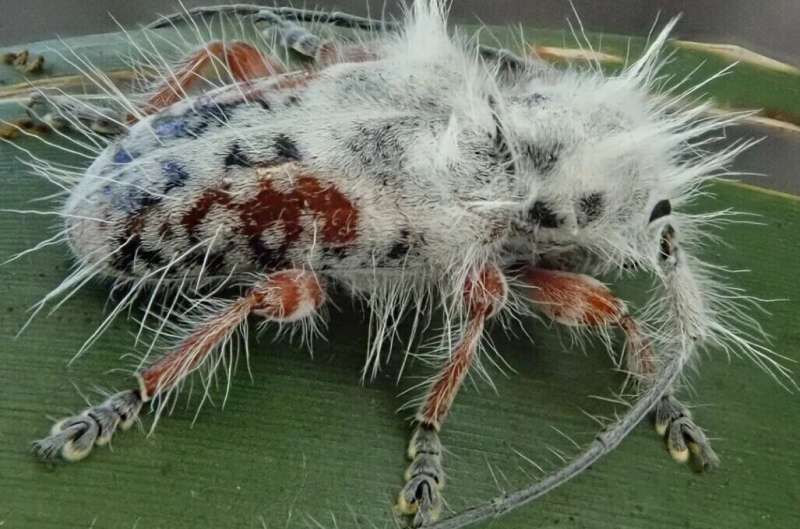This article has been reviewed according to Science X's editorial process and policies. Editors have highlighted the following attributes while ensuring the content's credibility:
fact-checked
trusted source
proofread
Chance sighting reveals new species of fluffy beetle

A researcher from The University of Queensland has discovered a remarkable new genus of fluffy longhorn beetle while camping within a rainforest in the Gold Coast hinterland.
The freshly named Excastra albopilosa was found by School of the Environment Ph.D. candidate James Tweed, who nearly mistook the beetle for bird droppings. A paper on the discovery has been published in the Australian Journal of Taxonomy.
"I was walking through the campsite at Binna Burra Lodge one morning and something on a Lomandra leaf caught my eye," Tweed said.
"To my amazement, I saw the most extraordinary and fluffiest longhorn beetle I had ever seen.
"Measuring 9.7 millimeters, it was a striking red and black beauty covered in long white hairs."
After the trip, Tweed searched through books, scientific papers and online to find a match for the species but nothing looked remotely similar.
Photos posted to an Australasian beetles Facebook group sparked plenty of interest but no answers from even the most seasoned identifiers.
An email to experts at the Australian National Insect Collection (ANIC) in Canberra confirmed the beetle was a completely new species.
It wasn't until Tweed visited ANIC to compare his discovery to their extensive collection that everyone realized it was not just a new species, but a new genus—or family of species—as well.
"We chose the name Excastra for the genus, which is Latin for 'from the camp,' and for the species name, we decided on albopilosa which translates to 'white and hairy,'" Tweed said.
"We don't yet know what these hairs are for, but our primary theory is that they make the insect look like it's been killed by an insect-killing fungus.
"This would possibly deter predators such as birds from eating it, but until someone can find more specimens and study this species further, we won't be able to say for sure why this beetle is so hairy.
"The area near Lamington National Park has been popular with entomologists for more than 100 years so it's puzzling that it hasn't been found until now.
"I've been back several times to look for more of them but haven't had any luck."
Tweed said chance discoveries like these highlight how many unknown species could be out there and how many of those could be under threat from extinction.
"We're experiencing rapid declines in biodiversity globally, and it's difficult to conserve species if we don't even know they exist," Tweed said.
"Insects are the most diverse group of animals on the planet but are also the most underappreciated and understudied.
"Best estimates suggest there may be 5.5 million insect species worldwide and only one-fifth of these have been named and described."
More information: James Tweed et al, Excastra albopilosa, a remarkable new genus and species of Lamiinae (Insecta: Coleoptera: Cerambycidae) from southeastern Queensland, Australia, Australian Journal of Taxonomy (2024). DOI: 10.54102/ajt.iv1x5
Provided by University of Queensland




















